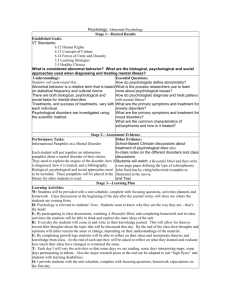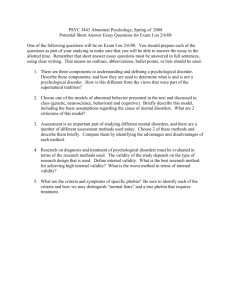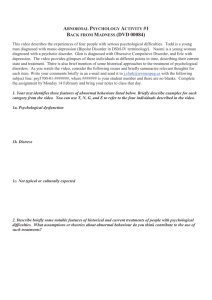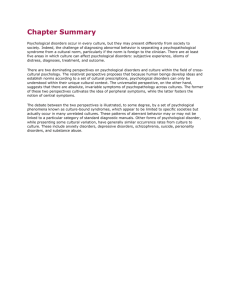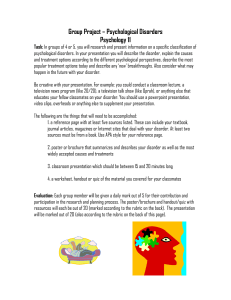Psychological Disorders
advertisement
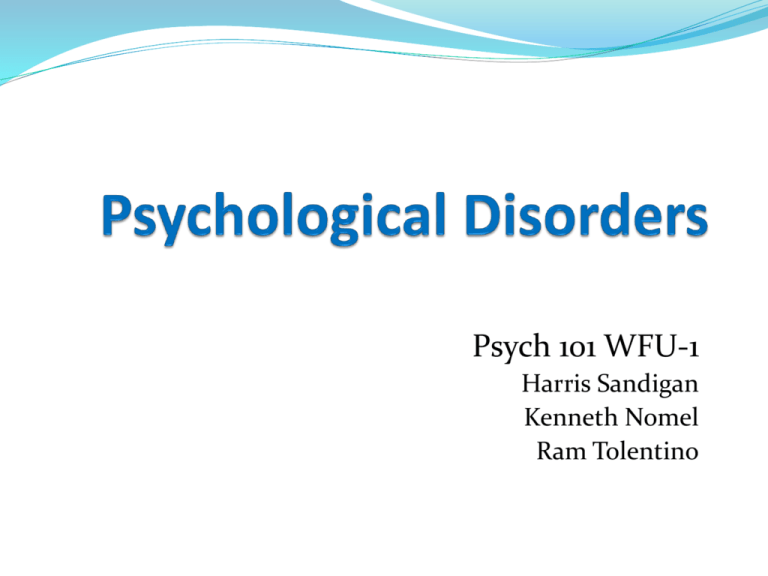
Psych 101 WFU-1 Harris Sandigan Kenneth Nomel Ram Tolentino Why study abnormal behavior? It raises many questions like: How should one react? What should be done to help? What kind of person develops a mental illness? Could this happen to someone close to you? Why study abnormal behavior? The key to answering these questions is to develop an understanding of just what is meant by abnormal behavior and the different ways in which behavior can depart from the “normal” path. What is meant by the term abnormal behavior? Psychopathology is the study of abnormal behavior Mental illness has been defined in various ways throughout history (e.g. possession, evil spirits, bodily imbalances) HISTORY OF PSYCHOLOGICAL DISORDERS A VERY BRIEF HISTORY OF PSYCHOLOGICAL DISORDERS > 300 B.C.E., archaeologists have found human skulls with small holes cut into them, and close examination indicates that the holes were made while the person was still alive. Source: wikipedia.com A VERY BRIEF HISTORY OF PSYCHOLOGICAL DISORDERS • The process is called trepanning (also spelled trephening), wherein it had to do with releasing the “demons” possessing the poor victim. Ancient people assumed that those who were behaving oddly were possessed by evil spirits. A VERY BRIEF HISTORY OF PSYCHOLOGICAL DISORDERS > Hippocrates (460-377 B.C.E) believed that illness of both the body and the mind were the result of imbalances in the body’s vital fluids, or humors (phlegm, black bile, blood and yellow bile) A VERY BRIEF HISTORY OF PSYCHOLOGICAL DISORDERS >People of the Middle Ages believed in the spirit possession (a belief influenced by the teachings of the Roman Catholic Church and the other religious and cultural systems) as one cause of abnormal behavior. The treatment for such maladies was exorcism or the formal casting out of the demon through religious ritual. EXORCISM What is abnormal? Defining abnormal or abnormality is not as simple as it might seem at first. We must consider different criteria and factors for determining abnormality. Factors defining abnormality Statistical Definition – frequently occurring behavior would be considered normal, and behavior that is rare would be abnormal. Social Norm Deviance- another way of defining abnormality is to see it as something that goes against the norms or standards of the society in which the individual lives. - situational context (the social or environmental setting of a person’s behavior) Factors defining abnormality Subjective Discomfort- one sign of abnormality is when the person experiences a great deal of emotional distress of emotional pain. However not all that might be considered abnormal create subjective discomfort. ex. Serial killer Inability to Function Normally- the person finds it hard to adapt to the demands of day-to-day living (maladaptive behavior). It also includes behavior that may initially help a person cope but has harmful or damaging effect. Factors defining abnormality The Sociocultural Perspective- abnormal behavior as well as normal behavior is seen as the product of the learning and shaping of behavior within the context of the family, the social group to which one belongs, and the culture within which family and social group exist. -cultural relativity, the need to consider the unique characteristics of the culture in which behavior takes place Factors defining abnormality -Culture-bound syndrome- disorders found only in particular cultures ex. Anorexia nervosa and bulimia nervosa are most often found in Western societies So how do psychologists decide what is abnormal? 1. Is the behavior unusual, such as experiencing severe panic when faced with a stranger or being severely depressed in the absence of any stressful life situations? 2.Does the behavior go against social norms? (And keep in mind that social norms change over timee.g., homosexuality was once considered a psychological disorder rather than a variation in sexual orientation.) 3.Does the behavior cause the person significant subjective discomfort? 4. Is the behavior maladaptive or result in an inability to function? 5.Does the behavior cause the person to be dangerous to self or others, as in the case of someone who tries to commit suicide or who attacks other people without reason? Abnormal behavior that includes at least two of these five criteria is perhaps best classified by the term psychological disorder, which is defined as any pattern of behavior that causes people significant distress, causes them to harm themselves or others, or harms their ability to function in daily life. Abnormality vs. Insanity Psychologists and psychiatrists determine whether or not certain behavior is abnormal, but they do not decide whether a certain person is insane. In U.S, insanity is not a psychological term; it is a legal term It [insanity] used to argue that a mentally ill person who has committed a crime should not be held responsible for his or her actions because he/she was unable to understand the difference between right and wrong at the time of the offense Abnormality vs. Insanity It is important to keep in mind that not everyone who has been diagnosed with a psychological disorder is a good candidate to use the insanity defense to plead innocent to a criminal charge. Models of Abnormality 1. Biological Model- model of explaining behavior as caused by biological changes in the chemical, structural or genetic systems of the body. 2. Psychological Model- disordered behaviors are the result of various forms of emotional, behavioral or thought-related malfunctioning. a. Psychodynamic View b.Behaviorism c. Cognitive Perspective 2. Psychological Models Psychodynamic view- explains disordered behavior as the result of repressing one’s threatening thoughts, memories and concerns in the unconscious mind Behaviorism- explains disordered behavior as being learned just like normal behavior Cognitive Perspective- abnormal behavior as resulting from illogical thinking patterns 3. Biopsychosocial Perspective The biological, psychological and sociocultural influences on abnormality are no longer seen as independent causes of abnormal behavior. Instead, these influences interact with one another to cause the various forms of disorders. It is a very influential way to view the connection between mind and body. What are the different types of psychological disorders and how common are they? In 1952, the first edition of the Diagnostic and Statistical Manual of Mental Disorder (DSM) was published to help psychological professionals diagnose psychological disorders The current version of DSM is called Diagnostic and Statistical Manual of Mental Disorders, Fourth Edition, Text Revision (DSM-IV-TR) DSM-IV-TR describes about 250 different psychological disorders. Each disorder is described in terms of its symptoms The manual also divides these disorders and relevant facts about the person being diagnosed along five different axes. DMS-IV-TR Axis I- Clinical Disorders Axis II- Personality Disorders along with Mental Retardation Axis III- Physical Disorders that affects person’s psychological well-being Axis IV- Problems in the Person’s life Axis V- Global Assessment of Functioning (overall judgment made by the psychological professional of the person’s mental health and adjustment) Pros and Cons of Labels Pros: 1. Helps psychological professionals diagnose patients and provide those patients with labels that explain their conditions. 2. Labels establish distinct diagnostic categories that all psychological professionals recognize and understand, and they help patients receive effective treatment. Pros and Cons of Labels Cons: 1. David Rosenhan concluded that psychological labels are long lasting and powerful, affecting not only how other people see mental patients but how patients see themselves. 2. It is very easy to see oneself in these disorders. Ex. Psychology students studying abnormal behavior can also become convinced that they have some mental disorder (psychology student’s syndrome) How common are psychological disorders? In any given year, about 26.2 percent of American adults over age 81 suffer from a mental disorder that comes to about 57.7 million people in U.S. Mental disorders are the leading cause of disability in U.S and Canada (National Institute of Mental Health, 2010) It is quite common to people to suffer from more than one mental disorder at a time (e.g. person with depression who also has substance disorder, anxiety disorder and sleeping disorder)
